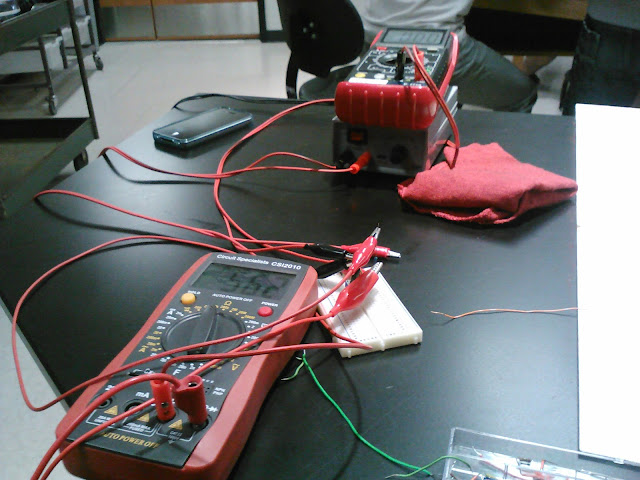First the following circuit is constructed:
where R0 is a variable resistor, in this case a potentiometer
| Nominal | Measured | |
| Resistor | 5.6 Kohm | 5.62+/-.02 Kohm |
| Voltage source | 4.5 V | 4.54 V |
The potentiometer was varied so that we could get readings of voltage and resistance coming from a wire attached to the potentiometer.
After getting values for voltage and resistance, we can compute the power through the potentiometer.
| Measured V0 (V) | Measured Rx (Kohms) | Calculated P0 (W) |
| 2.80+/-.01 | 14.64+/-.01 | 0.000536+/-.0000028 |
| 2.68+/-.02 | 13.73+/-.01 | 0.000523+/-.0000055 |
| 2.51+/-.01 | 12.55+/-.02 | 0.000502+/-.0000029 |
| 2.43+/-.01 | 12.08+/-.01 | 0.000488+/-.0000028 |
| 2.32+/-.02 | 11.50+/-.01 | 0.000468+/-.0000058 |
| 2.17+/-.01 | 10.77+/-.01 | 0.000437+/-.0000029 |
| 1.98+/-.01 | 10.00+/-.01 | 0.000392+/-.0000028 |
| 1.80+/-.02 | 9.34+/-.01 | 0.000347+/-.0000055 |
| 1.63+/-.02 | 8.78+/-.02 | 0.000303+/-.0000053 |
| 1.41+/-.01 | 8.17+/-.02 | 0.000244+/-.0000025 |
| 1.28+/-.01 | 7.82+/-.01 | 0.000210+/-.0000023 |
| 0.84+/-.01 | 6.89+/-.01 | 0.000103+/-0000017 |
| .02+/-.01 | 5.65+/-.02 | 0.00000007+/-.00000 |
| .00+/-.001 | 5.62+/-.02 | ~0 |
Analyzing the Thevenin equivalent circuit, we can calculate the theoretical voltage and power going through the potentiometer using voltage division;
where x is the value at which the potentiometer is set for every voltage.
| Theoretical V0 (V) | Theoretical Power (W) |
| 3.25 | 0.000721 |
| 3.20 | 0.000746 |
| 3.11 | 0.000771 |
| 3.07 | 0.000780 |
| 3.03 | 0.000798 |
| 2.96 | 0.000814 |
| 2.88 | 0.000829 |
| 2.81 | 0.000845 |
| 2.75 | 0.000861 |
| 2.67 | 0.000873 |
| 2.62 | 0.000878 |
| 2.48 | 0.000893 |
| 2.26 | 0.000904 |
| 2.25 | 0.000901 |
Looking at Fig. 2, we can observe that:
Max Power (0.536KW) occurs at 14.64kohms.
To get the theoretical value of the resistance at which max. power occurs, we solve for R in P = v^2/R, where the voltage is 2.80V (voltage at which max. power happens);
R = 2.80^2/0.000536 = 14626.87 ohms
% Error = 0.137%
Part B:
For the second part of this experiment we used Logger Pro software to obtain a graph of power. The circuit, however, was a little bit more complex;
| Nominal (kohms) | Measured (kohms) | |
| R1 | 1 | 0.966 |
| R2 | 10 | 9.85 |
| R3 | 10 | 9.86 |
| R4 | 1 | 0.976 |
| R5 | 1 | 0.979 |
| Nominal (V) | Measured (V) | |
| Voltage source 1 | 4.5 | 4.54+/-.01 |
| Voltage source 2 | 9 | 9.05+/-.01 |
| Logger Pro Graph Power vs. T |
The power graph was obtained by dictating a function that multiplies voltage and current. Unfortunately, the graphs for voltage and current were less than satisfactory due to the amount of error and the sensitivity of the probes.
| Notice the spikes on the voltage graph |
This results compromised the data analysis for this part.







No comments:
Post a Comment